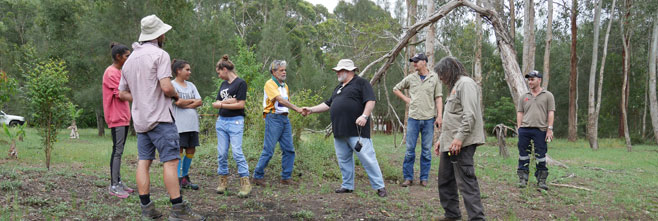
On Wednesday the 4th November the Firesticks project had a visit from our Federal Grant Manager Michael Miller from the Department of Environment. A group of rangers from Ngunya Jargoon and Minyumai Indigenous Protected Areas (IPA) joined Firesticks staff in showcasing some of the on-ground works achieved through Firesticks contracts and sharing some of the projects hurdles, highlights and positive results. The meeting started at Ngunya Jargoon IPA near Wardell, where the group was given a tour of the property by the IPA senior ranger Marcus Ferguson who highlighted the many significant cultural and ecological values on the property and pointed out on-ground works being achieved.
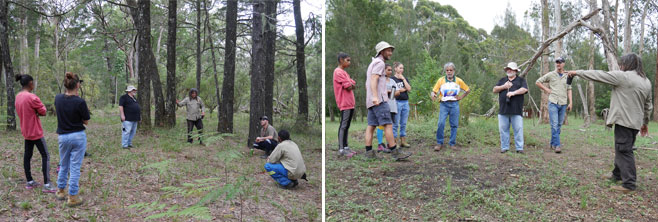
The group is shown the Cypress grove where clearing has been carried out to protect the trees; Marcus Ferguson explains the process of clearing away invasive coral trees from the area.
At Ngunya Jargoon IPA rangers have cleared around a significant stand of native cypress- Callitris columellaris, which is culturally important to the indigenous community at Ngunya Jargooon. The clearing aims to protect the trees from a potential wildfire if one should occur on the property. The group was then shown a wetland that has been regenerated after the removal of coral trees- Erythrina x sykesii, another invasive weed on the property.
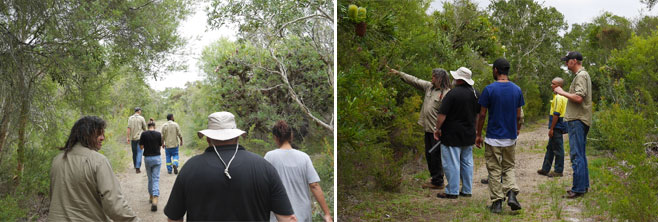
The group tours the Lumley’s Lane block to inspect the fire control lines and the state of the bush that is to be burnt.
The next location to visit was at Lumleys Lane, where the Ngunya Jargoon IPA rangers have prepared fire control lines so that the block of long unburnt banksia scrub may be burnt in the near future. This site has some peat areas which need to be managed carefully to prevent them from burning during the fire. The long unburnt heath vegetation coupled with the existence of peat soils around many areas of Ngunya Jargoon has been a major obstacle in obtaining hazard reduction certificates (HRC) to implement prescribed burns. Due to the technical difficulty in carrying out the proposed burns Firesticks has engaged Fireland Consultancy from Queensland to assist with the development of burn plans, training, mentoring and on-ground implementation. The Fireland crew have significant experience burning in similar long-unburnt heath communities in Queensland and are working with the rangers to develop ongoing strategies for implementing burns. The Firesticks project is committed to using adaptive management strategies to trial and develop practical solutions that support the aspirations of our project partners and build capacity in their ranger teams.
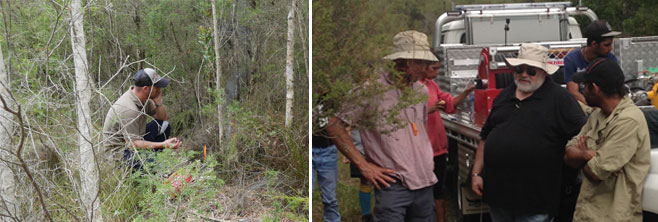
Joshua Bull from Fireland Consultancy conducts a test burn to assess conditions at the research plot. Ngunya Jargoon IPA manager Miles Holmes discusses the test burn with Daniel Gomes and Michael Miller
The group then moved onto assessing one of the long-term research plots to be burnt soon at Ngunya Jargoon IPA. After examining the control lines that have been created and maintained by the rangers a test burn was conducted by Joshua Bull from Fireland Consultancy to assess the conditions on the site.
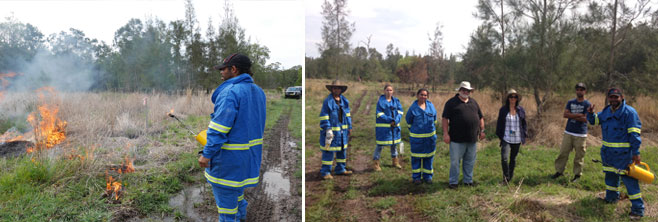
Rangers at Minyumai IPA show Michael Miller their techniques using fire to eradicate invasive Setaria grass from the wetland area.
After lunch the group took a tour of the Minyumai IPA property near Woodburn where the rangers conducted a burn on the Setaria plots. Through additional support from the Firesticks project the Minyumai IPA rangers have been conducting trial burns of the invasive grass Setaria- Setaria sphacelata var. sericea, in order to eradicate the weed from the wetland area. The results are impressive, with the occurrence of the weed dramatically reduced in each burn. The rangers shared their knowledge of management techniques with Michael, explaining the process of spraying and then burning the invasive grass. Daniel Gomes, head ranger at Minyumai IPA recently attended the SEQ Fire and Weeds Conference in Brisbane where he presented to over 200 people about the work Minyumai has been doing in controlling Setaria grass and regenerating the property with native species.
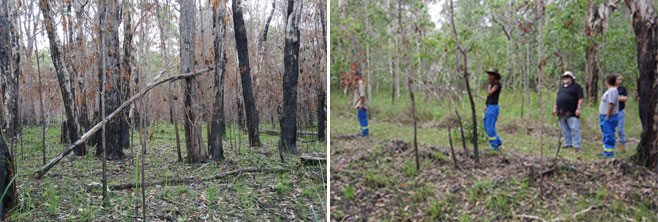
Regenerating grasses after the burn in plot C at Minyumai IPA, The group inspects the research plot and native grass regrowth since the burn.
The final stop on the tour of Minyumai IPA was to inspect the results of a burn at research plot C where the rangers have recently conducted a burn. The regrowth of native grasses after the burn shows the resilience and vigour of native plants in response to fire. A mother grey kangaroo and her joey were observed near the site- they had been grazing on the sweet new growth of grasses, showing that fauna benefit from the regeneration of grasses after appropriate fire has been applied.

